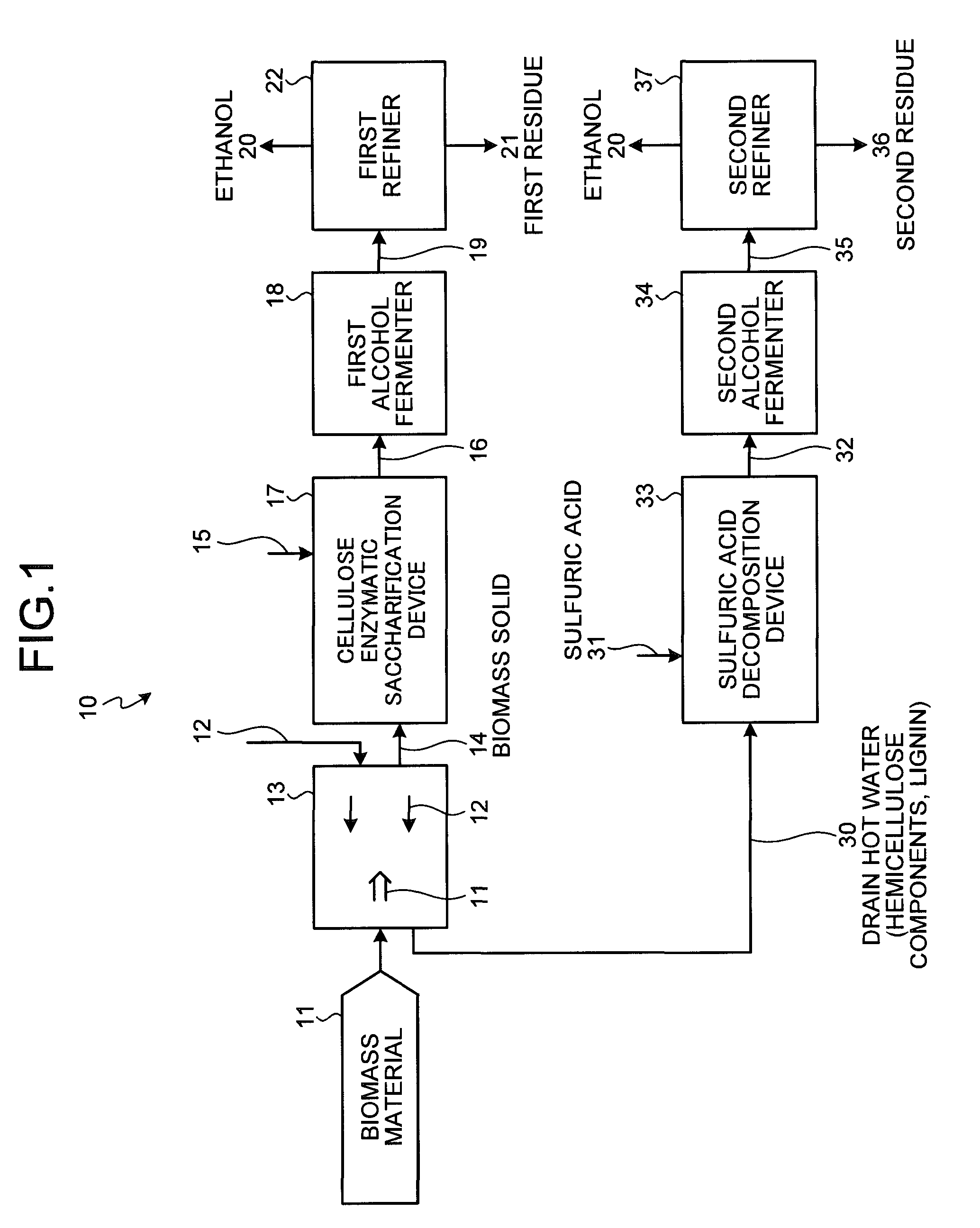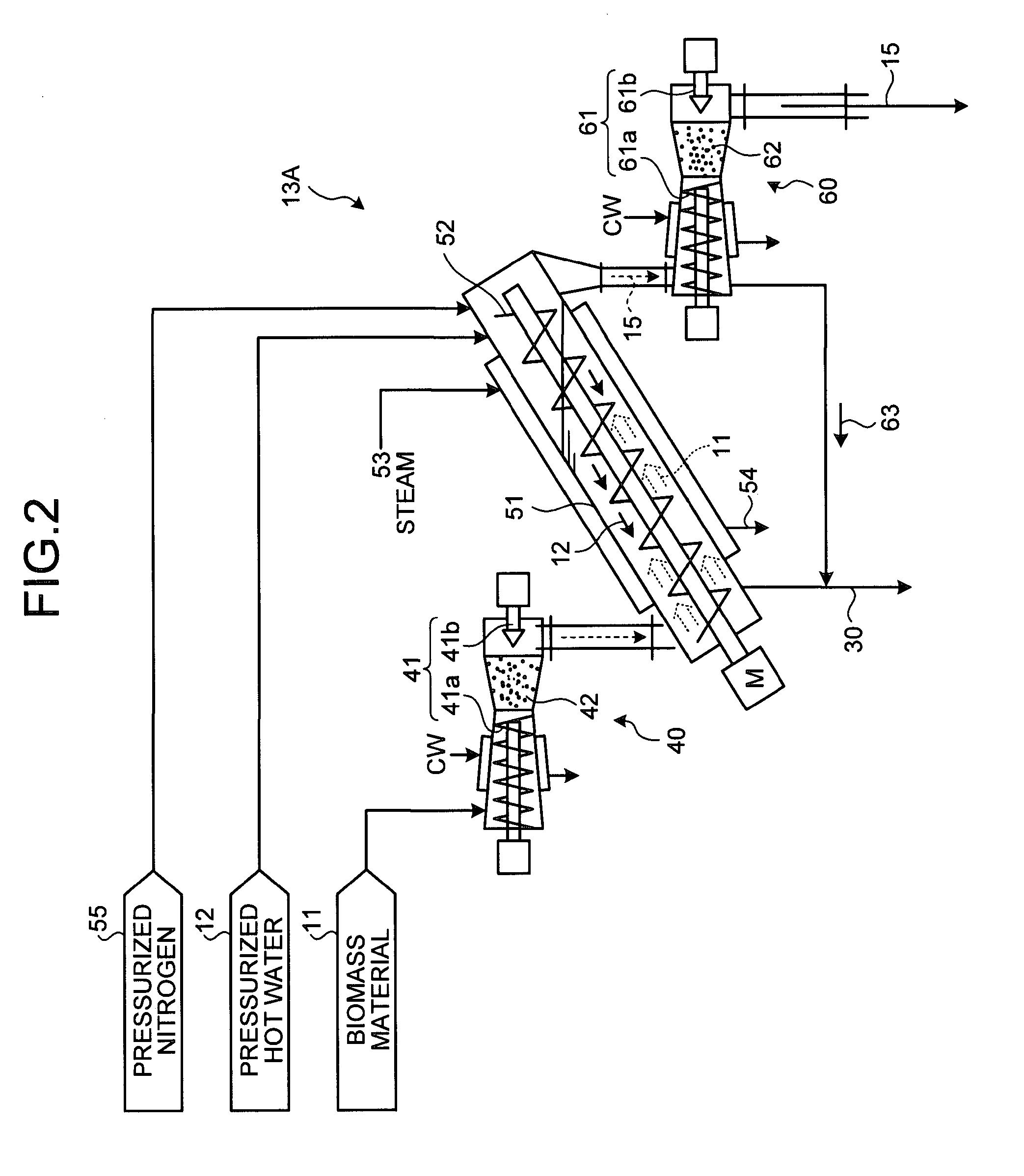Organic material production system using biomass material and method
a biomass material and production system technology, applied in the field of biomass hydrothermal decomposition apparatus, can solve the problems of increasing the cost of purchasing equipment, increasing the cost of disposing of used sulfuric acid, and the cost of recovering such sulfuric acid, and achieve the effect of efficient saccharification and good efficiency
- Summary
- Abstract
- Description
- Claims
- Application Information
AI Technical Summary
Benefits of technology
Problems solved by technology
Method used
Image
Examples
first embodiment
[0047]A system of producing an organic material, i.e., alcohol, with use of biomass material according to an embodiment of the present invention is described with reference to the drawings. FIG. 1 is a schematic of an organic material production system using biomass material according to the present embodiment. As shown in FIG. 1, an alcohol production system 10 using biomass material according to the present embodiment includes: a hydrothermal decomposition apparatus 13 that causes a biomass material 11 and hot compressed water 12 to countercurrently contact with each other and undergo hydrothermal decomposition, transfers lignin components and hemicellulose components into the hot compressed water 12, and separates the lignin components and the hemicellulose components from a biomass solid residue; a cellulose enzymatic saccharification device 17 that feeds an enzyme (cellulase) 15 into a biomass solid residue 14, which is discharged from the hydrothermal decomposition apparatus 1...
second embodiment
[0073]With reference to the drawings, the following describes an embodiment of a biomass thermal decomposition apparatus used in the alcohol production system 10 using biomass material according to the present invention. FIG. 2 is a schematic of a biomass hydrothermal decomposition apparatus according to the embodiment. As shown in FIG. 2, a biomass hydrothermal decomposition apparatus 13A according to the present embodiment includes: a biomass feeder 40 that feeds a biomass material 11 under normal pressure to under increased pressure; the hydrothermal decomposition apparatus 13A that allows the fed biomass material (e.g., wheat straw in the present embodiment) 11 to be gradually conveyed inside a slanted device main body (hereinafter, “device main body”) 51 from a lower end thereof with a conveyor screw 52, and also allows hot compressed water 12 to be fed into the device main body 51 from an upper end thereof, which is different from a feed section for the biomass material 11, so...
third embodiment
[0088]With reference to the drawings, the following describes another embodiment of the biomass hydrothermal decomposition apparatus used in the alcohol production system 10 using biomass material according to the present invention. FIG. 3 is a schematic of a biomass hydrothermal decomposition apparatus according to the present embodiment. As shown in FIG. 3, a biomass hydrothermal decomposition apparatus 13B according to the present embodiment includes: a biomass feeder 80 that feeds the biomass material (e.g., wheat straw in the present embodiment) 11 under normal pressure to under increased pressure; a horizontal device main body (hereinafter, “device main body”) 70 that allows the fed biomass material 11 to be gradually moved therethrough from an end on either the left or the right side (on the left side in the present embodiment) thereof in a consolidated condition, and also allows the hot compressed water 12 to be fed therein from an end (on the right side in the present embod...
PUM
| Property | Measurement | Unit |
|---|---|---|
| Temperature | aaaaa | aaaaa |
| Temperature | aaaaa | aaaaa |
| Temperature | aaaaa | aaaaa |
Abstract
Description
Claims
Application Information
 Login to View More
Login to View More - R&D
- Intellectual Property
- Life Sciences
- Materials
- Tech Scout
- Unparalleled Data Quality
- Higher Quality Content
- 60% Fewer Hallucinations
Browse by: Latest US Patents, China's latest patents, Technical Efficacy Thesaurus, Application Domain, Technology Topic, Popular Technical Reports.
© 2025 PatSnap. All rights reserved.Legal|Privacy policy|Modern Slavery Act Transparency Statement|Sitemap|About US| Contact US: help@patsnap.com



